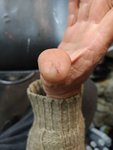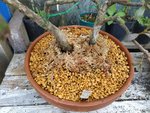fredman
Masterpiece
Sounds simple...well maybe it is, but there's a few things that concerns me.
I killed a few in the past by letting them get to dry. They don't show it immediately as other trees do (or maybe I didn't observe close enough). They get the drought damage, and just start deteriorating...and die a few weeks later.
It's easy to keep them wet..just water them to much. But herein lies my concern. I removed one yesterday that has been in a deepish azalea pot for about 3 years...highly organic soil that kept it's moisture...way to much. I was flabbergasted to see it's roots did not grow one half inch. I literally just lifted it out the pot as it was put in 3 three years ago.
Since I lost the others from drought i've been keeping the remaining ones wet...figured rather that than to dry. Big mistake to. To wet is just as bad...well almost.
What Paul Eslinger said in a video keeps ringing in my head...."if they are kept to wet, they get lazy and the roots don't extend".
Herein lies my other concern...where is that fine line with an azalea?
I mean, think about it...the right way then, would be to withhold water until the outer edge of the rootball starts drying before watering again. Well that's where the fine and delicate azalea roots live...and they can't take any drying out...!
I have two different soils to learn about to...kanuma and ericacious potting soil.
Man I have my watering work cut out for me this season...then again, hopefully i'm over thinking things again.
Anyway, I guess my questions are...How much do you water your azaleas? Do you let them dry? How dry?
Feeling the weight of the pot works for me with other trees, but I can't see it working with kanuma...it's soooo light, and I have heavy pots...uh uh
I killed a few in the past by letting them get to dry. They don't show it immediately as other trees do (or maybe I didn't observe close enough). They get the drought damage, and just start deteriorating...and die a few weeks later.
It's easy to keep them wet..just water them to much. But herein lies my concern. I removed one yesterday that has been in a deepish azalea pot for about 3 years...highly organic soil that kept it's moisture...way to much. I was flabbergasted to see it's roots did not grow one half inch. I literally just lifted it out the pot as it was put in 3 three years ago.
Since I lost the others from drought i've been keeping the remaining ones wet...figured rather that than to dry. Big mistake to. To wet is just as bad...well almost.
What Paul Eslinger said in a video keeps ringing in my head...."if they are kept to wet, they get lazy and the roots don't extend".
Herein lies my other concern...where is that fine line with an azalea?
I mean, think about it...the right way then, would be to withhold water until the outer edge of the rootball starts drying before watering again. Well that's where the fine and delicate azalea roots live...and they can't take any drying out...!
I have two different soils to learn about to...kanuma and ericacious potting soil.
Man I have my watering work cut out for me this season...then again, hopefully i'm over thinking things again.
Anyway, I guess my questions are...How much do you water your azaleas? Do you let them dry? How dry?
Feeling the weight of the pot works for me with other trees, but I can't see it working with kanuma...it's soooo light, and I have heavy pots...uh uh





